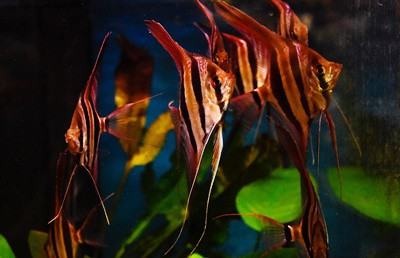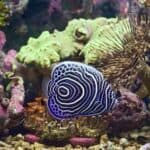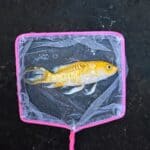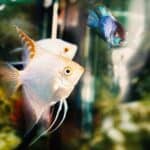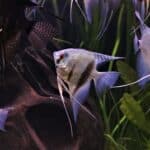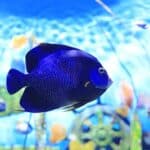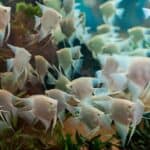Last Updated on: 16th April 2024, 11:17 am
We need to know how many fish can fit safely in a tank. Overcrowding is a problem if a tank is too small, and angelfish can start to get lonely if kept in a large tank without any company.
A tank should have a minimum of 10 gallons of water per angelfish. Many owners use the 1 fish per gallon rule when calculating how many angelfish to put into a tank.
This doesn’t always take into account plants and accessories. The 1-fish-per-2-gallons rule, or measuring the aquarium’s floor space and surface area is more accurate.
Angelfish prefer wider tanks that have space at the bottom. They get along with other community fish species but dislike living in overcrowded conditions.
How Many Angelfish Should Be Kept Together?
Many variables should be considered to determine how many angelfish should be in an aquarium.
Angelfish are among the most demanding fish regarding their tank and environmental conditions. They prefer tanks with little movement and are kept at temperatures of between 75-82°F.
The water’s pH must be around 6.8-7, which is almost neutral. Toxic chemicals can occur when the pH is too low or high.
The tank should be a minimum of 20 gallons for a pair of angelfish. Similarly, there must be 10 gallons for each angelfish added to the tank.
There are 3 methods for calculating how many angelfish should be kept in a tank. They are as follows:

One Inch Per Gallon Rule
The one-inch per gallon rule is the most popular way to calculate the number of angelfish.
The rule is simple: your tank can hold one inch of fish per gallon of water. This calculation uses the length of the angelfish as a measurement.
While this seems like an easy calculation to follow, it doesn’t consider the fish’s height or plants and other decorations inside the tank. As a result, your angelfish may not have enough room to swim once everything has been added to the aquarium.
A more effective calculation is to measure the angelfish’s height and add 10 gallons of water to account for the additional items inside the tank.
Based on the one inch per gallon rule, the safe number of angelfish per gallon should be:
| Number of Fish | Gallons |
| 2 | 34 |
| 4 | 58 |
| 6 | 82 |
| 8 | 106 |
| 10 | 130 |
One Inch Per Two Gallons Rule
Many owners dislike the one-inch-per-gallon rule because it can lead to overstocking. Instead, they use the one inch per two gallons rule for growing fish.
The concept is the same but allows for more water in the tank.
Also, because you’re calculating more space for the angelfish, you don’t need to add the extra 10 gallons to account for what’s inside the aquarium.
The one-inch-per-two-gallon rule also means you don’t have to carry out as many water changes, as the quality will remain suitable for longer.
Based on the one inch per two gallons rule, the safe number of fish per gallon should be:
| Number Of Fish | Gallons |
| 2 | 48 |
| 4 | 96 |
| 6 | 144 |
| 8 | 192 |
| 10 | 240 |
Aquarium Floor And Surface Area
A final, more accurate way to determine how many angelfish should be in a tank is to calculate the tank’s floor and surface area.
To do this, measure the width of the tank, not the height. This allows more room and accounts for angelfish preferring territory at the bottom of the tank. This can reduce aggression inside the aquarium.
This calculation is based on the angelfish needing 12 square inches of surface space. Follow these steps to calculate how many fish can fit inside your tank:
- Measure the length and width of your tank and multiply the two to determine the surface area.
- Divide the surface area by 12. This will give you the total number of inches of angelfish your tank has space for.
- Divide the answer you’ve gotten by 12, which is the height of the angelfish.
You now have your answer, telling you how many angelfish will comfortably fit into your tank.
| Number Of Fish | Square Inches |
| 2 | 300 |
| 3 | 450 |
| 4 | 600 |
| 5 | 800 |
| 6 – 7 | 1000 |
Things To Consider When Calculating Tank Space
Calculations are an accurate way to figure out how many fish to place inside your tank. However, many other variables must be considered to provide your fish with a safe and comfortable environment.
Consider the following factors when calculating tank space:
Tank Dimensions
Tank dimensions are one of the most essential considerations when calculating how many fish it can hold.
As mentioned, many fish prefer wider aquariums as opposed to tall ones. They provide extra swimming space and allow a wider turning radius.
Many fish also enjoy foraging at the bottom of the tank and sifting through the substrate.
This is where they commonly claim territory. Wider tanks allow more room at the bottom of the aquarium, which pleases angelfish and keeps them busy.
Fish Behavior
Understanding the natural behavior of angelfish before committing to a specific amount is essential. This is because fish species vary and have different tank requirements.
For example, angelfish are shoaling fish that like to be in small groups. They stay close to each other to conserve their energy. As a result, angelfish fare better with slightly less space.
Like convict cichlids, other fish species form pair bonds and kill submissive fish. As a result, the fish need more space to hide from each other and swim away. They also do better in larger groups where weaker fish can hide, so you’d need a large tank to accommodate the fish.
Plants And Accessories
As we’ve already touched upon, you must consider the plants and accessories inside your tank, as they take up valuable swimming space.
Plants are essential, as they produce oxygen and absorb carbon dioxide and ammonia, benefiting the tank’s ecosystem. They also provide shelter for fish and help to reduce algae growth.
However, if you pack the tank with too many plants and accessories, fish can become territorial and aggressive as they compete for room.
Therefore, always factor in the number of plants and accessories you have or are planning to have, and try not to add any more once you’ve made your calculations – unless you’re replacing dead plants.
Filtration
Filtration is often overlooked but integral to keeping your tank’s water clean and healthy. If you overstock your tank, the filter will struggle to work efficiently, and harmful chemicals are more likely to develop inside the tank.
As a rule of thumb, filters should be able to pass your tank’s water 4 times in 1 hour. Any less than this, and your fish are at risk of ammonia poisoning and other chemical-related diseases.
Problems with Overstocked Tanks
There are no benefits to an overstocked tank. While it might look like the fish are thriving inside the tank, it’s rarely true. When too many fish are in a tank that’s too small, mental and physical problems are rife.
You mustn’t overstock your tank with angelfish; otherwise, the following problems can occur:
Poor Water Quality
Ammonia, nitrites, and a build-up of harmful bacteria are some of the most severe consequences of adding too many fish to a tank.
In tanks with neutral pH levels, ammonia is present but converted by beneficial bacteria into nitrite.
While nitrite is harmful in large quantities, the tank’s filtration system turns it into nitrate. Water changes also clean out these chemicals.
When too many fish are present, harmful ammonia levels are produced by fish excrement and urine.
The tank’s filter can’t work quickly enough to remove these chemicals, leading to potentially fatal ammonia and nitrite poisoning. When ammonia poisoning affects fish, it kills quickly.
Aggression
During mating season, angelfish become aggressive and territorial over other fish in the tank. This leads to conflict – sometimes angelfish lock lips to fight and bite each other’s tails and fines.
Small aquariums also limit the amount of space angelfish have to care for their eggs, causing them to become territorial to protect them.
Similarly, when there’s not enough room for the angelfish to flee and hide from the dominant angelfish, they fight. This causes fin, tail, and eye injuries. It also leads to death when angelfish are severely hurt.
Angelfish who have to fight for the small amounts of territory in the tank take their aggression out on each other.
Under or Overfeeding
Too many fish in the tank commonly leads to quieter fish missing their fair share of food. Dominant, aggressive angelfish eat all available food, causing them to overfeed.
Underfeeding and overfeeding have serious health consequences for angelfish. Underfeeding leads to:
- Weight loss.
- Lethargy.
- Inability to swim.
- Starvation.
Overfeeding leads to:
- Constipation.
- Swollen belly.
- Digestive problems.
- Fatty liver disease.
- Fin rot.
Both cases can lead to death, so you must limit the fish inside the tank and monitor how much they eat to have an equal share.
Stunted Fish Growth
Fish without enough space to thrive may suffer from stunted growth. Some experts believe this is because fish release hormones that suppress growth to adapt to their surroundings.
Coupled with stress and low water quality from overcrowding, angelfish can’t reach their full growth potential and remain smaller. As a result, long-term health conditions can shorten the fish’s lifespan.
Increased Stress Levels
Stress is a significant problem for angelfish, as it causes various health problems. Tank overstocking is directly responsible for:
- Poor water quality.
- High ammonia levels.
- Low oxygen levels.
- Disease.
- Lack of swimming space.
- Aggressive fish.
- Under or overfeeding.
- Lack of hiding spaces.
- Inadequate tank size.
- Poor nutrition.
All of these factors increase stress levels and cause angelfish to become unwell. Angelfish hide their stress well because this makes them vulnerable to predators. The signs of angelfish stress include:
- Lethargy.
- Rapid or erratic swimming.
- Loss of appetite.
- Color changes.
- Gasping at the tank’s surface.
- Hiding.
- Rapid health deterioration.
One of the easiest ways to prevent stress is to ensure your tank is adequately stocked and not overfilled.
Algae Overload
Another problem that an overcrowded tank causes is that various forms of algae grow, coating the entire tank’s surface and causing problems for the aquarium’s inhabitants.
Algae feed off nitrogen compounds, including ammonia and nitrite—fewer fish result in fewer nitrogen concentrations in the water, which helps to prevent algae infestations.
However, algae overgrowth is hard to control if the overstocking problem isn’t addressed. The algae will return, and you’ll spend most of your time cleaning the aquarium.
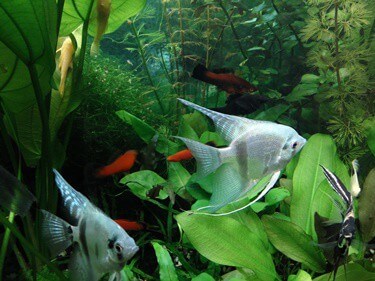
Can I Keep One Angelfish in A Community Tank?
Keeping a single angelfish alone in a community tank is possible, but it depends on its tank mates. Angelfish can become territorial and bully smaller fish. They may try to eat smaller fish.
Angelfish are also shoaling fish, so they are likely to miss the company of their species. As a result, angelfish do well in groups with other fish.
While it’s safest to keep angelfish in small groups, they also get along with the following fish species:
- Larger tetras.
- Rainbowfish.
- Gourami.
- Corydoras.
- Larger rasboras.
- Catfish.
- Mollies.
- Plecos.
They can also live with other cichlids, but avoiding aggressive fish like Oscars is recommended. Also, don’t house angelfish with crustaceans and invertebrates, as they see them as prey and will eat them.
Suitable cichlid tank mates include:
- Discus.
- Dwarf cichlid.
- Bolivian ram.
Your angelfish won’t easily bully these fish, which can stop them from becoming aggressive and territorial.
Can I Have An Odd Or Even Number Of Angelfish?
To create a harmonious tank, it’s best to have an even number of angelfish, including an exact number of each sex, so they can pair off and mate. This also stops males from competing for breeding rights.
When you have an odd number of angelfish, there’s a risk that the others could form pairs to single out odd angelfish.
An odd number of same-sex angelfish is more likely to fare better, but there’s still a chance that a lone angelfish could get singled out. However, the benefit of keeping same-sex angelfish is that there’s no chance of breeding.
If you have angelfish that breed, the tank can become quickly overstocked with new fish that grow to be adult-sized quite rapidly, making the tank’s size far too small.
Do Angelfish Need To Be In Groups?
As a minimum, your angelfish should be kept in a pair. Angelfish prefer living in small schools like they do in the wild. Being in shoals helps to lower angelfish’s stress levels and conserve energy.
Larger groups of angelfish also help with:
- Mating.
- Breeding.
- Establishment of social hierarchy.
- Prevent boredom and loneliness.
Angelfish that are kept alone may also become stressed, leading to various health problems, including velvet disease, bacterial infections, and poor skin and scale quality.
A study published by the National Library of Medline found that angelfish kept in isolation reduced their activity levels to a minimum after 3 to 4 days.
Another study by Experientia discovered that isolated angelfish fed less readily than fish kept in groups, suggesting that angelfish who live alone lose their appetite and are at a higher risk of starvation.
As a result, angelfish do best in groups of around five or six. This number helps prevent angelfish from becoming singled out and bullied and reduces the risk of the fish becoming territorial.
If you must keep an angelfish alone in a bare tank, ensure the fish is mature. Older fish are more territorial and more likely to bully smaller fish. Sometimes, aggressive angelfish must be quarantined to reset this behavior or protect fish in the main aquarium.
Similarly, angelfish suffering from parasitic or bacterial diseases must live alone to receive the appropriate treatment. If this is the case with your fish, monitor its behavior for any signs of stress or distress.
You’ll need to calculate how many fish your tank can hold so they don’t become stressed. You also don’t want to risk angelfish competing for space. If in doubt, underfill the tank so they have enough room.

